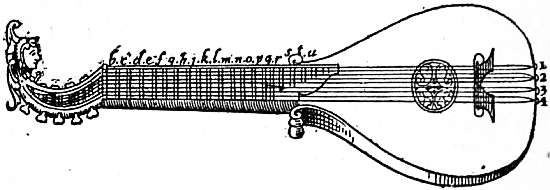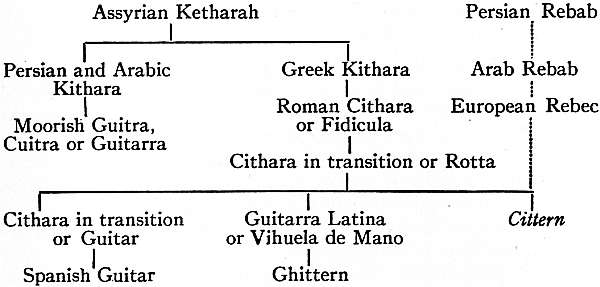Cittern
 From Britannica 11th Edition (1911)
From Britannica 11th Edition (1911) Cittern (also Cithern, Cithron, Cythren, Citharen, &c.;
Fr. citre, cistre, cithre, guitare allemande or anglaise; Ger. Cither,
Zither (mit Hals, with neck); Ital. cetera, cetra), a medieval
stringed instrument with a neck terminating in a grotesque and
twanged by fingers or plectrum. The popularity of the cittern
was at its height in England and Germany during the 16th and
 17th centuries. The cittern consisted
of a pear-shaped body
similar to that of the lute but
with a flat back and sound-board
joined by ribs. The neck was provided with a fretted finger-board;
the head was curved and surmounted by a grotesque
head of a woman or of an animal.1 The strings were of wire in
pairs of unisons, known as courses, usually four in number in
England. A peculiarity of the cittern lay in the tuning of the
courses, the third course known as bass being lower than the
fourth styled tenor.
17th centuries. The cittern consisted
of a pear-shaped body
similar to that of the lute but
with a flat back and sound-board
joined by ribs. The neck was provided with a fretted finger-board;
the head was curved and surmounted by a grotesque
head of a woman or of an animal.1 The strings were of wire in
pairs of unisons, known as courses, usually four in number in
England. A peculiarity of the cittern lay in the tuning of the
courses, the third course known as bass being lower than the
fourth styled tenor.
According to Vincentio Galilei (the father of the great astronomer) England was the birthplace of the cittern.2 Several lesson books for this popular instrument were published during the 17th century in England. A very rare book (of which the British Museum does not possess a copy), The Cittharn Schoole, written by Anthony Holborne in 1597, is mentioned in Sir P. Leycester’s manuscript commonplace book3 dated 1656, “For the little Instrument called a Psittyrne Anthony Holborne and Tho. Robinson were most famous of any before them and have both of them set out a booke of Lessons for this Instrument. Holborne has composed a Basse-parte for the Viole to play unto the Psittyrne with those Lessons set out in his booke. These lived about Anno Domini 1600.” Thomas Robinson’s New Citharen Lessons with perfect tunings for the same from Foure course of strings to Fourteene course, &c. (printed London, 1609, by William Barley), contains illustrations of both kinds of instruments. The fourteen-course cittern was also known in England as Bijuga; the seven courses in pairs were stretched over the finger-board, and the seven single strings, fastened to the grotesque head, were stretched as in the lyre à vide alongside the neck; all the strings rested on the one flat bridge near the tail-piece. Robinson gives instructions for learning to play the cittern and for reading the tablature. John Playford’s Musick’s Delight on the Cithren (London, 1666) also contains illustrations of the instrument as well as of the viol da Gamba and Pochette; he claims to have revived the instrument and restored it to what it was in the reign of Queen Mary.
 |
| From Thomas Robinson’s New Citharen Lessons, 1609. |
| Four-course Cittern. |
The cittern probably owed its popularity at this time to the ease with which it might be mastered and used to accompany the voice; it was one of four instruments generally found in barbers’ shops, the others being the gittern, the lute and the virginals. The customers while waiting took down the instrument from its peg and played a merry tune to pass the time.4 We read that when Konstantijn Huygens came over to England and was received by James I. at Bagshot, he played to the king on the cittern (cithara), and that his performance was duly appreciated and applauded. He tells us that, although he learnt to play the barbiton in a few weeks with skill, he had lessons from a master for two years on the cittern.5 On the occasion of a third visit he witnessed the performance of some fine musicians and was astonished to hear a lady, mother of twelve, singing in divine fashion, accompanying herself on the cittern; one of these artists he calls Lanivius, the British Orpheus, whose performance was really enchanting.
Michael Praetorius6 gives various tunings for the cittern as well as an illustration (sounded an octave higher than the notation).

During the 18th century the cittern, citra or English guitar, had twelve wire strings in six pairs of unisons tuned thus:

The introduction of the Spanish guitar, which at once leapt into favour, gradually displaced the English variety. The Spanish guitar had gut strings twanged by the fingers. The last development of the cittern before its disappearance was the addition of keys. The keyed cithara7 was first made by Claus & Co. of London in 1783. The keys, six in number, were placed on the left of the sound-board, and on being depressed they acted on hammers inside the sound-chest, which rising through the rose sound-hole struck the strings. Sometimes the keys were placed in a little box right over the strings, the hammers striking from above. M.J.B. Vuillaume of Paris possessed an Italian cetera (not keyed) by Antoine Stradivarius,8 1700 (now in the Museum of the Conservatoire, Paris), with twelve strings tuned in pairs of unisons to E, D, G, B, C, A, which was exhibited in London in 1871.
The cittern of the 16th century was the result of certain transitions which took place during the evolution of the violin from the Greek kithara (see Cithara).
Genealogical Table of the Cittern.

The cittern has retained the following characteristics of the archetype. (1) The derivation of the name, which after the introduction of the bow was used to characterize various instruments whose strings were twanged by fingers or plectrum, such as the harp and the rotta (both known as cithara), the citola and the zither. In an interlinear Latin and Anglo-Saxon version of the Psalms, dated A.D. 700 (Brit. Mus., Vesp. A. 1), cithara is translated citran, from which it is not difficult to trace the English cithron, citteran, cittarn, of the 16th century. (2) The construction of the sound-chest with flat back and sound-board connected by ribs. The pear-shaped outline was possibly borrowed from the Eastern instruments, both bowed as the rebab and twanged as the lute, so common all over Europe during the middle ages, or more probably derived from the kithara of the Greeks of Asia Minor, which had the corners rounded. These early steps in the transition from the cithara may be seen in the miniatures of the Utrecht Psalter,9 a unique and much-copied Carolingian MS. executed at Reims (9th century), the illustrations of which were undoubtedly adapted from an earlier psalter from the Christian East. The instruments which remained true to the prototype in outline as well as in construction and in the derivation of the name were the ghittern and the guitar, so often confused with the cittern. It is evident that the kinship of cittern and guitar was formerly recognized, for during the 18th century, as stated above, the cittern was known as the English guitar to distinguish it from the Spanish guitar. The grotesque head, popularly considered the characteristic feature of the cittern, was probably added in the 12th century at a time when this style of decoration was very noticeable in other musical instruments, such as the cornet or Zinck, the Platerspiel, the chaunter of the bagpipe, &c. The cittern of the middle ages was also to be found in oval shape. From the 13th century representations of the pear-shaped instrument abound in miniatures and carvings.10
A very clearly drawn cittern of the 14th century occurs in a MS. treatise on astronomy (Sloane MS. 3983, Brit. Mus.) translated from the Persian of Albumazar into Latin by Georgius Zothari Zopari Fenduli, priest and philosopher, with a prologue and numerous illustrations by his own hand; the cittern is here called giga in an inscription at the side of the drawing.
References to the cittern are plentiful in the literature of the 16th and 17th centuries. Robert Fludd11 describes it thus: “Cistrona quae quatuor tantum chordas duplicatas habet easque cupreas et ferreas de quibus aliquid dicemus quo loco.” Others are given in the New English Dictionary, “Cittern,” and in Godefroy’s Dict. de l’anc. langue franç. du IXe au XVe siècle.
1 See Shakespeare, Love’s Labour’s Lost, act v. sc. 2, where Boyet compares the countenance of Holofernes to a cittern head; John Forde, Lovers’ Melancholy (1629), act ii. sc. 1, “Barbers shall wear thee on their citterns.”
2 Dialogo della musica (Florence, 1581), p. 147.
3 The musical extracts from the commonplace book were prepared by Dr Rimbault for the Early English Text Society. Holborne’s work is mentioned in his Bibliotheca Madrigaliana. The descriptive list of the musical instruments in use in England during Leycester’s lifetime (about 1656) has been extracted and published by Dr F.J. Furnivall, in Captain Cox, his Ballads and Books, or Robert Laneham’s Letter (1575), (London, 1871), pp. 65-68.
4 See Knight’s London, i. 142.
5 See De Vita propria sermonum inter liberos libri duo (Haarlem, 1817) and E. van der Straeten, La Musique aux Pays-Bas, ii. 348-35O.
6 Syntagma Musicum (1618). See also M. Mersenne, Harmonie universelle (Paris, 1636), livre ii. prop. xv., who gives different accordances.
7 See Carl Engel, Catalogue of the Exhibition of Ancient Musical Instruments (London, 1872), Nos. 289 and 290.
8 See note above. Illustration in A.J. Hipkins, Musical Instruments; Historic, Rare and Unique (Edinburgh, 1888).
9 For a résumé of the question of the origin of this famous psalter, and an inquiry into its bearing on the history of musical instruments with illustrations and facsimile reproductions, see Kathleen Schlesinger, The Instruments of the Orchestra, part ii. “The Precursors of the Violin Family,” pp. 127-166 (London, 1908-1909).
10 An oval cittern and a ghittern, side by side, occur in the beautiful 13th-century Spanish MS. known as Cantigas de Santa Maria in the Escorial. For a fine facsimile in colours see marquis de Valmar, Real. Acad. Esq., publ. by L. Aguado (Madrid, 1889). Reproductions in black and white in Juan F. Riaño, Critical and Bibliog. Notes on Early Spanish Music (London, 1887). See also K. Schlesinger, op. cit. fig. 167, p. 223, also boat-shaped citterns, figs. 155 and 156, p. 197. Cittern with woman’s head, 15th century, on one of six bas-reliefs on the under parts of the seats of the choir of the Priory church, Great Malvern, reproduced in J. Carter’s Ancient Sculptures, &c., vol. ii. pl. following p. 12. Another without a head, ibid. pl. following p. 16, from a brass monumental plate in St Margaret’s, King’s Lynn.
11 Historia utriusque Cosmi (Oppenheim, ed. 1617) i. 226.
↧ Download as ZWI file | Last modified: 11/17/2022 15:23:30 | 26 views
☰ Source: https://oldpedia.org/article/britannica11/Cittern | License: Public domain in the USA. Project Gutenberg License
 ZWI signed:
ZWI signed: KSF
KSF